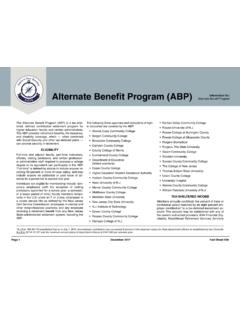Transcription of Technical Fact Sheet – 2,4,6-Trinitrotoluene (TNT)
1 United States Office of Land and Emergency EPA 505-F-17-009 Environmental Protection Agency Management (5106P) November 2017 1 Technical fact Sheet 2,4,6-Trinitrotoluene (TNT) November 2017 Introduction This fact Sheet , developed by the Environmental Protection Agency (EPA) Federal Facilities Restoration and Reuse Office (FFRRO), provides a summary of 2,4,6-Trinitrotoluene (TNT), including its physical and chemical properties; environmental and health impacts; existing federal and state guidelines; detection and treatment methods; and additional sources of information.
2 This fact Sheet is intended for use by site managers and field personnel who may address TNT contamination at cleanup sites or in drinking water supplies. Major manufacturing of TNT began in the United States in 1916 at the beginning of World War I. Production increased between World War I and World War II. TNT was produced and used in enormous quantities during World War II (EPA 2005). In demilitarization operations conducted up to the 1970s, explosives were removed from munitions with jets of hot water. The effluent flowed into settling basins and the remaining water was disposed of in unlined lagoons or pits.
3 The effluent from TNT manufacturing and demilitarization acted as a major source of munitions contamination in soils and groundwater at munition plants (EPA 2005). TNT is still widely used in military munitions and accounts for a large portion of the explosives-related contamination at active and former military installations. With its manufacturing impurities and environmental transformation products, TNT presents various health and environmental concerns. What is TNT? TNT is a yellow, odorless solid that does not occur naturally in the environment.
4 It is made by combining toluene with a mixture of nitric and sulfuric acids (ATSDR 1995). It is a single-ring nitroaromatic compound that is a crystalline solid at room temperature (CRREL 2006). TNT is one of the most widely used military explosives, partly because of its insensitivity to shock and friction. It has been used extensively in the manufacture of explosives since the beginning of the 20th century and is used in military shells, bombs and grenades (ATSDR 1995; Cal/EPA 2010). At a Glance Synthetic product that does not occur naturally in the environment.
5 Used extensively in the manufacture of munitions and accounts for a large part of the explosives contamination at active and former military installations. Sorbed by most soils, limiting its migration to water. Not expected to persist for a long period in surface waters because of transformation processes. 1,3,5-Trinitrobenzene (1,3,5-TNB) is one of the primary photodegradation products of TNT in environmental systems. Classified as a Group C (possible human) carcinogen. Primarily damages the liver and blood systems if inhaled or ingested.
6 The primary laboratory methods for analysis include liquid and gas chromatography. Potential treatment technologies include in situ bioremediation, granular activated carbon treatment, composting and incineration. Disclaimer: The EPA prepared this fact Sheet using the most recent publicly-available scientific information; additional information can be obtained from the source documents. This fact Sheet is not intended to be used as a primary source of information and is not intended, nor can it be relied upon, to create any rights enforceable by any party in litigation with the United States.
7 Mention of trade names or commercial products does not constitute endorsement or recommendation for use. Technical fact Sheet 2,4,6-TNT 2 Technical fact Sheet 2,4,6-TNT It has been used either as a pure explosive or in binary mixtures. The most common binary mixtures of TNT are cyclotols (mixtures with RDX) and octols (mixtures with octahydro-1,3,5,7-tetranitro-1,3,5,7-tet razocine [HMX]) (ATSDR 1995). In addition to military use, small amounts of TNT are used for industrial explosive applications, such as deep well and underwater blasting.
8 Other industrial uses include chemical manufacturing as an intermediate in the production of dyestuffs and photographic chemicals (HSDB 2012). TNT is commonly found at hand grenade ranges, antitank rocket ranges, artillery ranges, bombing ranges, munitions testing sites and open burn/open detonation (OB/OD) sites (CRREL 2006, 2007b; EPA 2012c). Production of TNT in the United States is currently limited to military arsenals; however, it may be imported into the United States for industrial applications (Cal/EPA 2010; HSDB 2012).
9 Effluent from TNT manufacturing is a major source of munitions constituent contamination in soils and groundwater at military ammunition plants (EPA 2005). Exhibit 1: Physical and Chemical Properties of TNT (ATSDR 1995; HSDB 2012; Ware 1999) Property Value Chemical Abstracts Service (CAS) number 118-96-7 Physical description (physical state at room temperature) Yellow, odorless solid Molecular weight (g/mol) Water solubility at 20 C (mg/L) 130 Octanol-water partition coefficient (Log Kow) (measured) Soil organic carbon-water coefficient (Koc) 300 (estimated) Boiling point ( C) 240 (explodes) Melting point ( C) Vapor pressure at 20 C (mm Hg) x 10-4 Specific gravity at 20 C Henry s law constant (atm-m3/mol at 20 C) x 10-7 Abbreviations.
10 G/mol grams per mole; mg/L milligrams per liter; C degrees Celsius; mm Hg millimeters of mercury; atm-m3/mol atmosphere -cubic meters per mole. Existence of TNT in the environment TNT can be released to the environment through spills, disposal of ordnance, OB/OD of ordnance, le aching from inadequately sealed impoundments and demilitarization of munitions. The compound can also be released from manufacturing and munitions processing facilities (ATSDR 1995). As of 2016, TNT had been identified at 30 sites on the EPA National Priorities List (NPL) (EPA 2016).















